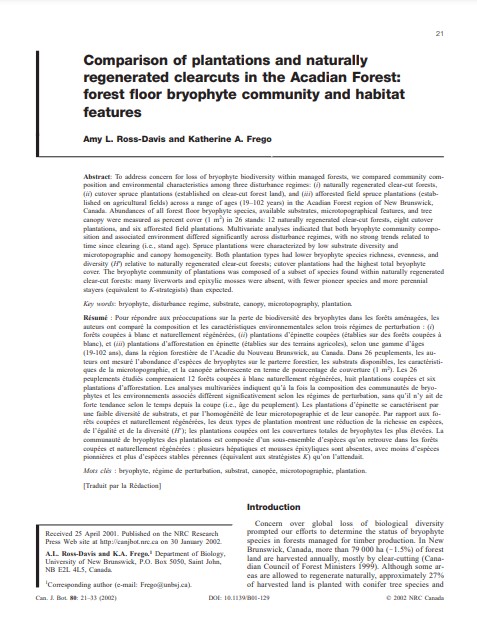Comparison of plantations and naturally regenerated clearcuts in the Acadian Forest: forest floor bryophyte community and habitat features
Bosque Modelo:
Fundy
Temática:
Conservación
Tipo de documento:
Artículo científico
Resumen
To address concern for loss of bryophyte biodiversity within managed forests, we compared community composition and environmental characteristics among three disturbance regimes: (i) naturally regenerated clear-cut forests, (ii) cutover spruce plantations (established on clear-cut forest land), and (iii) afforested field spruce plantations (established on agricultural fields) across a range of ages (19–102 years) in the Acadian Forest region of New Brunswick, Canada. Abundances of all forest floor bryophyte species, available substrates, microtopographical features, and tree canopy were measured as percent cover (1 m2 ) in 26 stands: 12 naturally regenerated clear-cut forests, eight cutover plantations, and six afforested field plantations. Multivariate analyses indicated that both bryophyte community composition and associated environment differed significantly across disturbance regimes, with no strong trends related to time since clearing (i.e., stand age). Spruce plantations were characterized by low substrate diversity and microtopographic and canopy homogeneity. Both plantation types had lower bryophyte species richness, evenness, and diversity (H¢) relative to naturally regenerated clear-cut forests; cutover plantations had the highest total bryophyte cover. The bryophyte community of plantations was composed of a subset of species found within naturally regenerated clear-cut forests: many liverworts and epixylic mosses were absent, with fewer pioneer species and more perennial stayers (equivalent to K-strategists) than expected.
Información Bibliográfica
Autor:
Ross-Davis A and KA Frego.
Revista:
Canadian Journal of Botany
Año:
2002
N°:
-
País :
Canadá
Páginas:
21 - 33
Volumen:
80
Idioma:
Ingles
Palabras claves
bryophyte, disturbance regime, substrate, canopy, microtopography, plantation.





